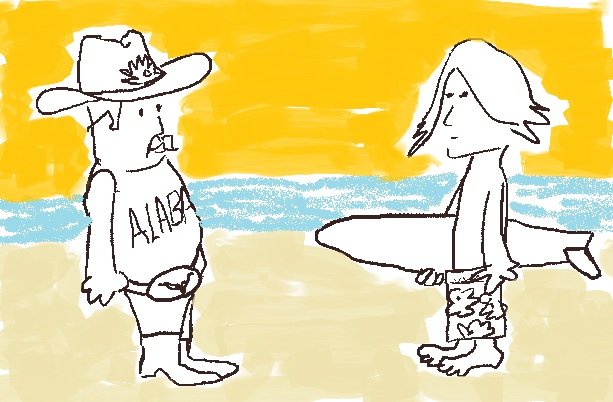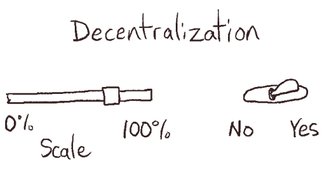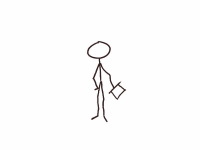Rednecks and surfers explain Web3
Back in school, the bathrooms were scary places. The older slacker boys lurked in there all day. They were professional, expert slackers. They interviewed any of the younger boys entering their lair. Scary places.
I avoided the bathrooms. However, sometimes, you gotta go.

Web 0.0
One day I went in the restroom and no one was there. Whew. The slackers must have been on break. Whilst taking care of business, I read the wall. It informed me that:
Rednecks rule
Okay, I did not know that before entering.
A day or two later, I returned to the same restroom, same spot. The wall then read in a different handwriting:
Rednecks rule
Surfers rule
(Yes, rednecks vs surfers. It was an eclectic school, I guess.)
A day or two later, the wall read:
Rednecks rule
Surfers rule
Surfers suck. Rednecks rule
Next day:
Rednecks rule
Surfers rule
Surfers suck. Rednecks rule
Rednecks suck. Surfers rule
And one more day:
Rednecks rule
Surfers rule
Surfers suck. Rednecks rule
Rednecks suck. Surfers rule
&@%! surfers
I think you get the point of the back-and-forth which went on adn degraded even furher. But, my point here is that this type of thing, hand hand prints on a prehistoric wall, this type of thing is the original social media...social media with all its glory. Call it Web 0.0.
It was actually rather pure in its form: it was decentralized, uncensored, and anonymous. I guess you could be censored with a coat of paint, but you're still not de-platformed and that might just be considered a new front end...a new and fresh beginning. You could even start again with a new username.
Web 1.0
The WWW (which no one calls it that anymore) used to be called "the information superhighway" (which no one calls it that either anymore). It worked and looked like this:

CSS and Javascript upped the game considerably in terms of visuals and usage. I recall when I first came across CSS Zen Garden. It was amazing that the same html code could be shown in such wildly different manners with one click. You can try it on their page by simply clicking one of the style sheets like "steel" or "apothecary". The content is the same, the look is different.
Thinking about it right now, this is a perfect analogy for Hive's front ends (which took me a while to understand). On Hive, the raw content is stable (and you can see it on something like https://hiveblocks.com). Though unchanged, the various front ends like PeakD, ecency, dbuzz, pob, vyb, dlux, etc... make it look different. And yet, the content is the same.
Personally, I'm a fan of the plain, clear minimalism of Web 1.0. If I make a website, I use one of two formats. Either the "Doggone Minimal Website" on GitHub for a one-pager. Below is same web page seen above, but changing to the Doggone Minimal format:

To move beyond a web page and into a website, I use "PureCSS" that retains real simplicity. This format is great because its looks and functions wonderfully on any device. On a mobile device, it looks, feels and behaves like a native app...one thats downloaded onto your phone, even though it's just a website. Look at nefties.com as an example...and if you're on laptop/desktop, resize your browser to see how the user experience (UX) responds accordingly...simple and clean and just a bit beyond Web 1.0. Maybe web 1.5.
Web 2.0
I'd always thought of Web 2.0 as a visual upgrading from the text-based Web 1.0. However, a quick search told me Web 2.0 is all about user-created content (think Wikipedia) and interaction (think social media). It's where users can post stuff and then interact with other users. I guess the difference is that web 1 was static, web 2 is dynamic.
This makes me wonder, by this definition, wouldn't the bathroom wall be considered Web 2.0?
Web3
Hive definitely meets the Web 2.0 standards, no question. Elon Musk recently tweeted about not seeing Web3 yet. There was some response from Hivers, saying essentially, "It's here on Hive!" I had to look up Web3.
This Wired article defined Web3 as:
a decentralized online ecosystem based on the blockchain
This is Hive.
If you want to argue, and it's fun to argue, you could say that "decentralization" is a sliding scale, say 1 to 100, it's not a toggle switch yes/no. And, you might say that with its witnesses as block producers (is it 30 witnesses?), you could argue that everyone else is simply out. The rest of us rely on those central witnesses. To me, this is parsing words. I think most people on Hive know what happens when one or a few people go rogue and try to grab power. 30 witnesses who are voted in or out is decentralized enough for me.

I will add something that evidently I was incorrect about. I thought Web3 referred to the internet itself being decentralized. Here I'm referring to the nuts-and-bolts, the wires and pulleys that enable us to connect my computer right here to that one in Australia. Howdy mate.
We still rely on ISPs and TCP/IP to do this. ISPs can flip the shut off switch...how's the connectivity in North Korea?
My thinking was that Web 3 was talking about connecting with others electronically in a truly decentralized way. Somehow, each user is their own internet service provider.
I've heard rumors of such things:
- A mesh network that uses radio waves to connect computers and transfer info. Your laptop sends a radio signal to another, which in turn relays it to others, and so on in a mesh.
- This is not just an idea, it's a product called goTenna which I think is cool.
- Somewhat similarly, I'm intrigued by the Othernet Dreamcatcher product. It's a radio that receives sound and text data. It is a one-way internet, you cannot post/broadcast. It's the same as how your portable radio can listen, but cannot broadcast. Yet, you don't need an internet connection with the Dreamcatcher. Being one-way only, this is definitely not Web 3.0, but it's cool still. Kind of like being able to read a newspaper each morning from all over the world for free would still be cool.
- And, looking at the Othernet forum, I see there is Skycoin. Don't know anything about it, but it's now on the radar.
- I used to use Blockstack a fair amount and was/is a fan. As I understand, it was/is the internet that cannot be shut down...it's decentralized. They had/have many actually usable and useful dapps at browser.blockstack.org, however they changed to using something called Stacks.js which is a wallet that I can't figure out. If they can get the UX improved, there is hope.
- And then, back to Elon Musk, his Starlink (cnet article) plans to load the skies with satellites beaming broadband. This would not be decentralized in my view, unless and until those satellites or others are running truly decentralized nodes with decentralized software. So, if Elon was to decide to pull the plug on Starlink...the genie is already out of the bottle.
A summary
It seems that Hive does indeed qualify as a Web3 dapp.
- Hive is in fact a decentralized ecosystem on a blockchain.
- It also contains the Web 2.0 characteristics of user-created content and the social media component.
- It also contains Web 1.0 in all its static glory.
- Hive does not contain Web 0.0's bathroom wall scribbles, however.
And yet, I still don't know if rednecks or surfers rule.

Not on Hive yet? The top benefits of the Hive blockchain:
- YOU control your account. Another person, group, or corporation cannot censor, block, or ban you at their whim.
- YOU own your content. YOU earn the rewards that YOUR content generates. Ask yourself, "Who earns when I post great content on the old social media outlets?"
Join Hive.
Learn more or consider using my referral link to get your free Hive account here.
<><
You are forgetting that 99.9% of the internet got tired of DDoS attacks and contracted one company to mitigate them. CloudFlare was called upon to deplatform 8chan, who then had to build its own DDoS protection. Hive uses it too and is vulnerable in the same way 8chan was.
As long as people take the easy way out by using big company bad actors like facebook for photos and cloudflare for every person that visits your site, there will be problems as governments crack down on people.
How am I forgetting this?